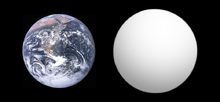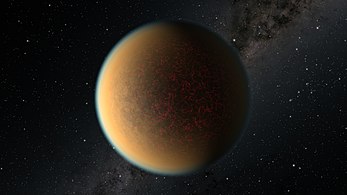| Revision as of 06:09, 6 April 2021 editGenQuest (talk | contribs)Autopatrolled, Extended confirmed users, Page movers, Pending changes reviewers, Rollbackers63,602 edits →References: templ ordr← Previous edit |
Revision as of 09:37, 6 April 2021 edit undo80.6.98.58 (talk) We insert a new peer-reviewed study which contradicts the findings of the previously mentioned study.Tag: Visual editNext edit → |
| Line 28: |
Line 28: |
|
The planet receives 19 times more ] than Earth.<ref name="Berta-Thompson2015"/> The temperature of the top of its atmosphere is estimated at {{convert|500|F|C K}}. The planet is estimated to be hotter than Venus, as higher temperatures may prevail near the surface.<ref name=Kowacki>{{cite web| url=http://www.csmonitor.com/Science/2015/1111/Spotted-A-rocky-Earth-sized-planet-close-by| title=Spotted: A rocky Earth-sized planet close by |work=]| date=2015-11-11| author=Eva Botkin-Kowacki}}</ref> ''(cf. ], ])'' It is possible that one side of the planet is cooler, because it is presumed to be ] due to its proximity to its star; however, under most circumstances where an atmosphere is thick, it would be able to transfer heat to the far side. |
|
The planet receives 19 times more ] than Earth.<ref name="Berta-Thompson2015"/> The temperature of the top of its atmosphere is estimated at {{convert|500|F|C K}}. The planet is estimated to be hotter than Venus, as higher temperatures may prevail near the surface.<ref name=Kowacki>{{cite web| url=http://www.csmonitor.com/Science/2015/1111/Spotted-A-rocky-Earth-sized-planet-close-by| title=Spotted: A rocky Earth-sized planet close by |work=]| date=2015-11-11| author=Eva Botkin-Kowacki}}</ref> ''(cf. ], ])'' It is possible that one side of the planet is cooler, because it is presumed to be ] due to its proximity to its star; however, under most circumstances where an atmosphere is thick, it would be able to transfer heat to the far side. |
|
|
|
|
|
In April 2017, a hydrogen-dominated atmosphere was claimed to have been detected around Gliese 1132 b.<ref>{{Citation|url = https://phys.org/news/2017-04-atmosphere-super-earth.html|title = Atmosphere around super-Earth detected|date = April 6, 2017|access-date = April 6, 2017}}</ref><ref name="Southworth2017"/> However, subsequent, more precise work ruled out the claim.<ref name="Diamond-Lowe2018"/> Instead, in 2021 detection of a hazy hydrogen atmosphere without helium but with the admixture ] and ] (implying substantial underlying free ] in the mix, at around 8.9% of the atmosphere) was claimed.<ref>{{citation|arxiv=2103.05657|year=2021|title=Detection of an Atmosphere on a Rocky Exoplanet}}</ref> |
|
In April 2017, a hydrogen-dominated atmosphere was claimed to have been detected around Gliese 1132 b.<ref>{{Citation|url = https://phys.org/news/2017-04-atmosphere-super-earth.html|title = Atmosphere around super-Earth detected|date = April 6, 2017|access-date = April 6, 2017}}</ref><ref name="Southworth2017"/> However, subsequent, more precise work ruled out the claim.<ref name="Diamond-Lowe2018"/> Instead, in 2021 detection of a hazy hydrogen atmosphere without helium but with the admixture ] and ] (implying substantial underlying free ] in the mix, at around 8.9% of the atmosphere) was claimed.<ref>{{citation|arxiv=2103.05657|year=2021|title=Detection of an Atmosphere on a Rocky Exoplanet}}</ref> However, another study found no evidence for molecular absorption in the HST WFC3 Spectrum of GJ 1132 b. Instead, the spectrum was found to be flat<ref>{{Cite journal|last=Mugnai|first=Lorenzo V.|last2=Modirrousta-Galian|first2=Darius|last3=Edwards|first3=Billy|last4=Changeat|first4=Quentin|last5=Bouwman|first5=Jeroen|last6=Morello|first6=Giuseppe|last7=Al-Refaie|first7=Ahmed|last8=Baeyens|first8=Robin|last9=Bieger|first9=Michelle Fabienne|last10=Blain|first10=Doriann|last11=Gressier|first11=Amélie|date=2021-04-05|title=ARES V: No Evidence For Molecular Absorption in the HST WFC3 Spectrum of GJ 1132 b|url=http://arxiv.org/abs/2104.01873|journal=arXiv:2104.01873 }}</ref>, which is more consistent with our current understanding of ]. |
|
|
|
|
|
==Gallery== |
|
==Gallery== |
It has been called "one of the most important planets ever discovered beyond the Solar System": Due to its relative proximity to Earth, telescopes should be able to determine the composition of its atmosphere, the speed of its winds and the color of its sunsets. This is due in part to the small diameter of its parent star (20% that of the Sun), which increases the effect on the star's light of its transits. The planet's diameter is approximately 20% larger than that of the Earth and its mass is estimated at 1.6 times that of Earth, implying that it has an Earth-like rocky composition. Gliese 1132 b orbits its star every 1.6 days at a distance of 1.4 million miles (2.24 million kilometres).
In April 2017, a hydrogen-dominated atmosphere was claimed to have been detected around Gliese 1132 b. However, subsequent, more precise work ruled out the claim. Instead, in 2021 detection of a hazy hydrogen atmosphere without helium but with the admixture methane and hydrogen cyanide (implying substantial underlying free nitrogen in the mix, at around 8.9% of the atmosphere) was claimed. However, another study found no evidence for molecular absorption in the HST WFC3 Spectrum of GJ 1132 b. Instead, the spectrum was found to be flat, which is more consistent with our current understanding of photoevaporation.




